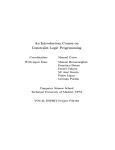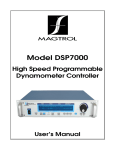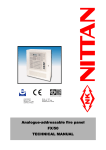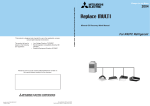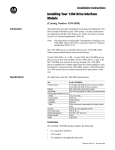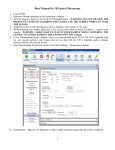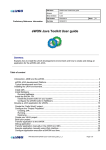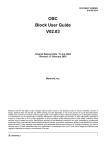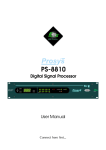Download SIMSIDES User Guide
Transcript
SIMSIDES User Guide José M. de la Rosa and Rocı́o del Rı́o Institute of Microelectronics of Seville, IMSE-CNM (CSIC/University of Seville) E-mail: [jrosa,rocio]@imse-cnm.csic.es Version 2.0, April 2013 CONTENTS 1 SIMSIDES User Guide 1.1 Getting Started: Installing and Running SIMSIDES 1.2 Building and Editing Σ∆M Architectures in SIMSIDES 1.3 Analyzing Σ∆Ms in SIMSIDES 1.4 Example 1.5 Getting Help 1 1 2 2 13 20 2 SIMSIDES Block Libraries and Models 2.1 Overview of SIMSIDES Libraries 2.2 Real SC Building-Block Libraries 2.2.1 Real SC Integrators 2.2.2 Real SC Resonators 2.2.3 Real CT Integrators 2.3 Real CT Building-Block Libraries 2.3.1 Real CT Resonators 2.4 Real Quantizers & Comparators 2.5 Real D/A Converters 2.6 Auxiliary Blocks 23 23 23 23 24 27 27 27 28 34 34 1 SIMSIDES User Guide SIMSIDES (SIMulink-based SIgma-DElta Simulator) is a time-domain behavioral simulator for Σ∆Ms that has been developed as a toolbox in the MATLAB/SIMULINK environment. SIMSIDES can be used for simulating any arbitrary Σ∆M architecture, implemented with both DT and CT circuit techniques. To this end, a complete list of Σ∆M building blocks (integrators, resonators, quantizers, embedded DACs, etc) is included in the toolboox. The behavioral models of these building blocks take into account the most critical error mechanisms of different circuit techniques including SC, SI, and CT circuits. These models, validated through transistor-level electrical simulations and by experimental measurements taken from a number of silicon prototypes, have been incorporated into the SIMULINK environment as C-MEX S-functions. This approach drastically increases the computational efficiency in terms of CPU time and accuracy of the simulation results. The behavioral models included in SIMSIDES have been compiled and tested in a number of operating systems, including Apple OS X, UNIX (Solaris), Linux, and Microsoft Windows. Both 32-bit and 64-bit system platforms have been successfully tested in the majority of them. Although SIMSIDES was originally developed using MATLAB 6.5 and SIMULINK 5, the toolbox has been updated and successfully used in a number of MATLAB/SIMULINK versions in the last years. This appendix provides a user guide of SIMSIDES, giving an overview of the most significant features of the simulator. 1.1 Getting Started: Installing and Running SIMSIDES A free copy of SIMSIDES can be downloaded from the following web site: http://www.imse-cnm.csic.es/simsides After completing the online registration form and accepting the terms and conditions for using SIMSIDES, a zip file named simsides.zip is downloaded. The following steps must be followed to install the toolbox: 1. Uncompress the simsides.zip file to a directory of your computer hard disk. Let us assume that the directory is named SIMSIDES . 2. Start MATLAB program. 3. Set the MATLAB search path in order to add the SIMSIDES directory. To do this, go to File menu in MATLAB and select Set Path. The Set Path dialog box Extracted from the book ”CMOS Sigma-Delta Converters: Practical Design Guide,” José M. de la Rosa and Rocı́o del Rı́o c 2013 John Wiley & Sons, Ltd. Published 2013 by John Wiley & Sons, Ltd. 2 SIMSIDES User Guide opens, listing all folders on the search path. From this dialog box, click the button Add with Subfolders and select the SIMSIDES directory to add to the search path. In order to reuse the newly modified search path including SIMSIDES directory and subdirectories, click Save, and finally click Close. This procedure–illustrated in Figure 1.1a–must be done only the first time SIMSIDES is installed in the hard disk. In order to start SIMSIDES, type simsides at the MATLAB prompt and the SIMSIDES main window is displayed, as illustrated in Figure 1.1b. 1.2 Building and Editing Σ∆M Architectures in SIMSIDES To create a new Σ∆M architecture in SIMSIDES, select File and then New Architecture in the main menu, and a new SIMULINK model window is displayed. Alternatively, an existing Σ∆M architecture can be opened by selecting File -> Open Architecture as illustrated in Figure 1.2. In order to define a Σ∆M block diagram in SIMSIDES, the required building blocks can be incorporated from the Edit menu as shown in Figure 1.3. Both SIMULINK and SIMSIDES library models can be included by selecting Edit -> SIMULINK Library or Edit -> Add block , respectively. The latter option allows users to browse through all SIMSIDES library models. This way, clicking on Edit -> Add blocka new window is displayed where the user can select either ideal or real building blocks, by choosing either Add Ideal Block or Add Real Block menus, respectively. In both cases, building-block models are organized in a set of sublibraries, namely: integrators, quantizers & comparators, D/A converters, resonators, and auxiliary blocks. The latter are only available in real libraries. Some model libraries are grouped in sublibraries that contain different models corresponding to different kinds of circuit implementations. For instance, if library Real Integrators is selected, a new window is displayed where the user can select the circuit technique (CT, SC, or SI) as well as the type of integrator (i.e., either FE or LD in the case of SC and SI integrators, and Gm-C, Gm-MC, active-RC, MOSFET-C in the case of CT integrators). As an illustration, Figure 1.3 shows different sublibraries contained in the Real Integrators library. A complete list of model libraries and sublibraries is given in Chapter 2 of this user guide. Once the Σ∆M block diagram is completed and the different building-block model parameters have been defined in the MATLAB workspace, the modulator can be simulated in SIMULINK following the same procedure as for the simulation of an arbitrary model in SIMULINK; i.e., choosing Simulation -> Start menu in the SIMULINK model window. 1.3 Analyzing Σ∆Ms in SIMSIDES Simulation output data can be post-processed in SIMULINK using the Analysis menu. As illustrated in Figure 1.4, the Analysis menu includes the following submenus: • Node Spectrum Analysis, which computes and plots the FFT magnitude spectrum of a given signal. • Integrated Power Noise, used for calculating and graphically representing the IBN within a given signal bandwidth. SIMSIDES User Guide 3 (a) (b) Figure 1.1 Installing and starting SIMSIDES: (a) Setting the MATLAB path. (b) Starting SIMSIDES at the MATLAB prompt. 4 SIMSIDES User Guide (a) (b) Figure 1.2 Building and editing Σ∆Ms in SIMSIDES: (a) Creating a new Σ∆M architecture. (b) Opening an existing model. • SNR/SNDR , which computes the SNR and/or SNDR within the band of interest, considering both LP- and BP-Σ∆Ms. • Harmonic Distortion, that computes dynamic harmonic distortion figures, like THD and intermodulation distortion figures. • Histogram, used for representing histograms and analyzing the input/output swing in Σ∆M building blocks. • INL/DNL, which calculates static harmonic distortion. • MTPR, used for computing multi-tone power ratio (MTPR). • Parametric Analysis , which allows to simulate the impact of a given model parameter on the performance of Σ∆Ms. • Monte Carlo Analysis, to do Monte Carlo simulations. The required parameters and details involving the aforementioned analysis menus are described below. SIMSIDES User Guide Figure 1.3 Illustrating different sublibraries included in the Real Integrators library. Figure 1.4 Analysis menu in SIMSIDES. 5 6 SIMSIDES User Guide Node Spectrum Analysis Figure 1.5a shows the SIMSIDES Node Spectrum Analysis window. The following parameters are required to compute the FFT magnitude spectrum: • Name of the signal(s) to process, where different variable names can be introduced, separated by commas. These variables can be output data generated in the simulations (for instance, the modulator output data stream), which have been previously saved in the MATLAB workspace by using the To Workspace SIMULINK block. • Sampling frequency; i.e., the sampling frequency in Hz. • Window, which defines the window function used for computing the FFT. The main window functions available in MATLAB can be selected, namely: Kaiser, Barlett, Blackman, Hamming, Hanning, Chebyshev, Boxcar, and Triangular. • Number of Points; i.e., the number of points (N in Figure 1.5) for the selected window function and for FFT computation. • Window Parameters, where other parameters required to define the window function are defined (like Beta parameter used in Kaiser windows). Once these parameters have been defined, the output spectrum can be computed by clicking on the Compute button and then selecting the signal to be processed from the new window that is displayed (Signal Spectrum window shown in Figure 1.5b). Integrated Power Noise Figure 1.6 shows the SIMSIDES Integrated Power Node window used for computing the IBN of any arbitrary data sequence obtained from simulations. To compute IBN, the following parameters are required: (a) Figure 1.5 (b) Node spectrum analysis menu. SIMSIDES User Guide 7 Figure 1.6 Integrated power noise menu. • Name of the signal(s) to process. • Sampling frequency; i.e., the sampling frequency in Hz. • Oversampling ratio; i.e., the value of OSR that defines the signal bandwidth in which the IBN is computed. • Input frequency, where it is assumed that a single-tone input signal is applied. • Window Parameters; i.e., the parameters required to defined the window function used for computing the IBN. • Kind of Spectrum, which specifies the signal nature; i.e., low-pass (LP) or bandpass (BP). After defining all parameters described above, the IBN is computed by clicking on the Compute button. Harmonic distortion can be also taken into account in the calculation of the IBN by clicking the Include Harmonic in Noise Power button. The signal spectrum can be also plotted together with the IBN by choosing the Include Signal Spectrum option. SNR/SNDR Figure 1.7 shows the SIMSIDES SNR/SNDR window. The parameters required to calculate the SNR/SNDR of a given signal are essentially the same as those used for computing IBN– described in the previous section. In this case either the SNR or the SNDR is computed 8 SIMSIDES User Guide depending on the Figure of merit selected. Note that this kind of analysis calculates the SNR/SNDR for a given value of the input signal amplitude. If a SNR-versus-amplitude curve is required, a parametric analysis should be chosen as will be described later. Harmonic Distortion Figure 1.8 shows the SIMSIDES Harmonic Distortion window, which is used for computing the harmonic distortion power. Two different figures of merit can be calculated, namely: THD and third-order intermodulation distortion (IM3 in Figure 1.8). The latter requires using a two-tone input signal. For that reason, there is an additional parameter named Input2 Frequency that defines the frequency of the second input tone. Integral and Differential Non-Linearity The INTEGRAL AND DIFFERENTIAL NON-LINEARITY menu, illustrated in Figure 1.9, is used for characterizing the static linearity in SIMSIDES. The analysis is based on either Histograms or Input Ramp Waveform–selected by the user. Other parameters required to do this analysis are the Input Amplitude and the Number of bits, which specifies the ideal resolution of the A/D conversion, expressed in bits. Figure 1.7 SNR/SNDR menu. SIMSIDES User Guide Figure 1.8 Harmonic distortion analysis menu. Figure 1.9 Integral and differential non-linearity analysis menu. 9 10 SIMSIDES User Guide Multi-Tone Power Ratio SIMSIDES can also analyze the harmonic distortion in those telecom applications such as ADSL, where a discrete multi-tone (DMT) signal is used. In this case, the linearity of the system is measured by a figure named multi-tone power ratio (MTPR). The corresponding SIMSIDES menu–shown in Figure 1.10–allows to compute MTPR for DMT input signals of different types: • Supressing 1 carrier of each 16; i.e., 1 out of 16 carrier channels are suppressed. • Supressing 8 carrier of each 128; i.e., 8 out of 128 carrier channels are suppressed. • Supressing 16 carrier of each 256; i.e., 16 out of 256 carrier channels are suppressed. In addition, the following parameters are also needed to compute MTPR: • Number of carriers, which stands for the number of carrier channels in which the DMT signal is divided. • Bins by carrier; i.e., the number of bins assigned to each carrier channel in the FFT. Figure 1.10 Multi-tone power ratio analysis menu. SIMSIDES User Guide 11 Histogram Histograms of signals that have been previously saved on the MATLAB workspace can be computed using the HISTOGRAM menu (illustrated in Figure 1.11), where the Number of bins specifies the number of intervals in which the signal range will be divided to compute the histogram. Parametric Analysis Figure 1.12 shows the SIMSIDES PARAMETRIC ANALYSIS menu. This menu is used for analyzing the impact of varying a model parameter on the performance of Σ∆Ms. Either one parameter or two parameters can be varied simultaneously by selecting the Second Parameter option. For each parameter, the following data must be specified: • Parameter Name; i.e., the name of the model parameter to be varied. This model parameter can be a variable used in a Σ∆M building block model (like for instance Io , gm , etc) or a simulation parameter, like the input signal amplitude, sampling frequency, etc. • Range [vi,vf], which defines the variation range, defined by an interval with a lower value given by vi and a upper value of vf. • N. of points; i.e., the number of points in which the variation interval is divided. • Scale, that specifies if the variation range is either linear or logarithmic. • Analysis, that specifies the type of analysis to be carried out, including output spectrum, IBN, SNR/SNDR, INL, MTPR, harmonic distortion, histograms, etc. Monte Carlo Analysis Figure 1.13 shows the SIMSIDES menu to run a Monte Carlo analysis. This is a particular case of parametric analysis, which has essentially the same functionalities and model parameters. The only difference is that the variation of the parameters involved in the Monte Figure 1.11 Histogram analysis menu. 12 SIMSIDES User Guide Figure 1.12 Parametric analysis menu. Figure 1.13 Monte Carlo analysis menu. Carlo analysis are randomly varied according to a probability distribution with a mean value and a standard deviation which are specified in the analysis menu. Different types of probability distributions can be chosen, including Normal, Log-Normal, Exponential, and Uniform distributions. 13 SIMSIDES User Guide 1.4 Example This section illustrates the use of SIMSIDES through a simple example in which several kinds of analysis will be carried out to show the main features of the toolbox. Figure 1.14 shows the block diagram of the modulator under study, which consists of a third-order cascade 2-1 DT-Σ∆M with single-bit quantization in both stages. Creating the Cascade 2-1 Σ∆M Block Diagram in SIMSIDES The modulator block diagram shown in Figure 1.14 can be implemented by using the model libraries available in SIMSIDES. To this end, the same procedure as described in Section 1.2 is followed: • Go to SIMSIDES main menu, select File -> New Architecture and introduce a name for the new Σ∆M architecture. • Include the integrators and comparators from the SIMSIDES model libraries. To do this, select Edit -> Add Block. In this example, the FE integrators in Figure 1.14 are implemented by using the SC_FE_Integrator_All_Effects blocks from the Real Integrators library, whereas single-bit quantizers are modeled by the Real_Comparator_Offset&Hysteresis comparator block available in Quantizers&Comparators library. These building blocks can be incorporated in the new architecture by simply dragging and dropping the models from their corresponding SIMSIDES libraries, as illustrated in Figure 1.15a. • Incorporate the remaining building blocks from the SIMULINK model library. To do this, go to Edit -> Simulink Library and drag the required models. In this example the following blocks are required: Sine Wave and Ground blocks from Sources library, Unit Delay and Discrete Filter block from the Discrete library, and To Workspace from Sinks library. • Finally, once all required blocks have been included in the new architecture, they are properly connected to implement the required Σ∆M architecture shown in Figure 1.15b. x 0.25 + - ! z −1 1 − z −1 1 +! - z −1 1 − z −1 z −1 + 0.5 0.25 + 1 0.5 +! - z −1 1 − z −1 2 + + ! (1 − z −1 )2 0.5 Digital Cancellation Logic Figure 1.14 Z-domain block diagram of a cascade 2-1 DT-Σ∆M. ! y 14 SIMSIDES User Guide Sine Wave Block To Workspace Block Ground Block (a) (b) Figure 1.15 SIMSIDES block diagram of the Σ∆M shown in Figure 1.14: (a) Building and editing the block diagram. (b) Complete modulator block diagram in SIMSIDES. SIMSIDES User Guide 15 Setting Model Parameters The modulator parameters and model parameters required to simulate the block diagram of Figure 1.15 can be either set up in the MATLAB command window or they can be alternatively saved in an M-file that is loaded when needed. As an illustration, Figure 1.16 shows the M-file used for setting up all model parameters of Figure 1.15, that also includes a brief description of the different parameters and variables included. For the sake of completeness, Table 1.1 includes the values of all building-block parameters as they are described in the SIMSIDES user masks, as well as other auxiliary block parameters (such as those used in Sine Wave and To Workspace blocks) which are required during simulation. In addition to these model parameters, simulation parameters must be set up to run a simulation. To do this, go to Simulation -> Simulation Parameters menu and define the following parameters: • Simulation Time: Start Time: 0.0 ; Stop Time: (N-1)*Ts % SDM parameters: % Sampling Frequency(fs), Input Frequency (fi), Sampling Time (Ts) % OverSampling Ratio (OSR=M); Number of points (N) fs=5.12e6; fi=5e3; Ts=1/fs; M=128; N=65536; % Model parameters kt=0.026*1.6e-19; % Boltzmann constant % First Integrator's parameters Cint1=24e-12; % integration capacitor For gain=1 Cs11=6e-12; % sampling capacitor (branch 1) Cs21=6e-12; % sampling capacitor (branch 2) innoise1=0; % rms value of the input equivalent noise ao1=2.63e3; % open-loop OTA DC gain gm1=4.5e-3; % transconductance io1=0.977e-3; % maximum OTA output current ron1=60; % sampling switch-on resistance % Second- and Third- Integrators Cint2=3e-12; Cs12=1.5e-12; Cs22=1.5e-12; innoise2=0; ao2=1.38e3; gm2=0.87e-3; io2=0.25e-3; ron2=650; % Common integrator parameters temp=175; % temperature osp=2.7; % output swing cnl1=0; % capacitor first-order non-linear coef. cnl2=25e-6; % capacitor second-order non-linear coef. avnl1=0; % DC gain first-order non-linear coef. avnl2=15e-2; % DC gain second-order non-linear coef. avnl3=0; % DC gain third-order non-linear coef. avnl4=0; % DC gain fourth-order non-linear coef. cpar1=0.6e-12; % parasitic (opamp) input capacitance cpar2=0.6e-12; cload=2.28e-12; % opamp (intrinsic) load capacitance % Comparators vref=2; % DAC reference voltage hys=30e-3; % comparator hysteresis Figure 1.16 M-file including all model parameters required to simulate the Σ∆M in Figure 1.15b. 16 SIMSIDES User Guide Table 1.1 Building-block model parameters used for simulating the Σ∆M in Figure 1.15b. Building Block Parameter Description Value/Variable Input Sine Wave Sine Type Amplitude Bias Frequency (rad/s) Phase (rad) Sample time Interpret vector parameters Time based 0.5 0 2*pi*fi 0 0 Selected First Integrator Integration and Sampling Capacitors (Branch 1, Branch 2) Capacitor nonlinear coefficients Weight’s variance, rms eq.input noise, temperature OTA DC gain, transconductance, max. output current Positive/Negative Output swing Switch on-resistance OTA DC gain nonlinear coefs. Parasitic capacitances before the OTA Load capacitance Positive Input 1 is sampled at... Sampling Time Identifier for this integrator Identifier for the next integrator [Cint1,Cs11,Cs21] [cnl1,cnl2] [0,innoise1,temp] [ao1,gm1,io1] [osp,-osp] ron1 [avnl1,2,3,4] [cpar1,cpar2] cload phi1 Ts a b Second, Third Integrators Integration and Sampling Capacitors (Branch 1, Branch 2) Capacitor nonlinear coefficients Weight’s variance, rms eq.input noise, temperature OTA DC gain, transconductance, max. output current Positive/Negative Output swing Switch on-resistance OTA DC gain nonlinear coefs. Parasitic capacitances before the OTA Load capacitance Positive Input 1 is sampled at... Sampling Time Identifier for this integrator (second integrator) Identifier for this integrator (third integrator) Identifier for the next integrator [Cint2,Cs12,Cs22] [cnl1,cnl2] [0,innoise2,temp] [ao2,gm2,io2] [osp,-osp] ron2 [avnl1,2,3,4] [cpar1,cpar2] cload phi1 Ts b c c Comparators Vhigh, Vlow Offset, Hysteresis Phase ON Sampling Time Identifier for this quantizer [vref, -vref] [0,hys] phi1 Ts quant1 To Workspace (y) Variable name Limit data points to last Decimation Sample Time Save format y N 1 Ts Array SIMSIDES User Guide 17 • Solver options: Type: Variable Step ; Max Step Size: Auto Note that integrator building blocks are identified in order to properly compute the equivalent load capacitances required for the incomplete settling error model. Computing Output Spectrum The output spectrum of the Σ∆M can be computed in SIMSIDES by following the next steps: • Set up model parameters by using the M-file shown in Figure 1.16. • Simulate the modulator in Figure 1.15b from the menu Simulation -> Start. • Once the simulation has finished, go to Analysis -> Node Spectrum Analysis menu in SIMSIDES. • Define the parameters requested in that menu. In this example, the sampling frequency is defined as fs and a Kaiser window function is used with a number of points N and Beta = 20. • Click on Compute and then Plot, and the output spectrum shown in Figure 1.17 is displayed. Modulator Output (Magnitude) Spectrum 0 −20 Magnitude (dB) −40 −60 −80 −100 −120 −140 −160 1 10 2 10 3 10 4 10 Frequency (Hz) 5 10 6 10 Figure 1.17 Output spectrum (magnitude) of the Σ∆M in Figure 1.15b. 18 SIMSIDES User Guide SNR versus Input Amplitude Level Figure 1.18 shows the SNDR versus input amplitude level (or SNDR curve) of the Σ∆M in Figure 1.15b. This figure has been obtained by using the Analysis menu and choosing SNR/SNDR analysis. In this example, the following parameters are used: • Parameter Name: Ain, where Ain is the Amplitude parameter defined in the Input Sine Wave block in Figure 1.15b. • Range [vi,vf]: [1e-6,2] • N. of points: 50 • Scale: Logarithmic • Analysis: SNR/SNDR • Second Parameter: Off Once the aforementioned parameters are set up, click on Continue and the SNR/SNDR window menu shown in Figure 1.7 is displayed. The requested parameters (i.e., sampling frequency, oversampling ratio, etc) are set up according to the values given in Figure 1.16, namely: SNDR vs. Input Amplitude Level 100 SNDR (dB) 80 60 40 20 0 −6 10 −5 10 −4 10 −3 10 Ain (V) −2 10 −1 10 0 10 Figure 1.18 SNDR versus input amplitude level of the Σ∆M in Figure 1.15b. SIMSIDES User Guide 19 • Name of the signal(s) to process: y • Sampling frequency (Hz): fs • Oversampling ratio: M • Input Frequency (Hz): fi • Window: Kaiser • N. of Points: N • Beta: 20 • Kind of Spectrum: LP • Figure of merit: SNDR After setting up the aforementioned parameters, click on Compute and then Plot to obtain the curve given in Figure 1.18. Parametric Analysis Considering Only One Parameter The Parametric Analysis menu can be used for studying the effect of a given model parameter on the modulator performance. For instance, let us consider the effect of the OTA transconductance gm of the front-end integrator in Figure 1.15b. In order to analyze the impact of this parameter on the effective resolution of the modulator, go to Parametric Analysis menu and set up the following parameters: • Parameter name: gm1, which stands for gm of the front-end integrator block in Figure 1.15b. • Range [vi,vf]: [1e-5,1e-3] • N. of points: 50 • Scale: Linear • Analysis: SNR/SNDR • Second Parameter: Off Once these parameters are defined, click on Continue and proceed in a similar way to previous examples in order to compute the SNDR. Figure 1.19 shows the results of this analysis, by depicting the SNDR versus gm1. Parametric Analysis Considering Two Parameters The Parametric Analysis menu can be used also for implementing parametric analyses considering the variation of two different parameters. As an example, Figure 1.20 shows the effect of both the OTA transconductance gm1 and the maximum output current Io1 of the front-end amplifier on the SNDR of the Σ∆M in Figure 1.15b. In order to obtain the graph in Figure 1.20, the following parameters are set up in the Parametric Analysis menu: • Parameter name: io1, which stands for the maximum output current Io of the front-end integrator. 20 SIMSIDES User Guide SNDR vs. gm1 110 100 90 SNDR (dB) 80 70 60 50 40 30 0 0.1 0.2 0.3 0.4 0.5 gm1 (A/V) 0.6 0.7 0.8 0.9 1 −3 x 10 Figure 1.19 Using parametric analysis to study the effect of a single model parameter: SNDR versus transconductance of the front-end amplifier for the Σ∆M in Figure 1.15b. • Range [vi,vf]: [1e-4,1e-3] • N. of points: 10 Computing Histograms Finally, to conclude this example, Figure 1.21 illustrates the histograms of the integrators outputs in the front-end stage of the modulator in Figure 1.15b. These histograms have been obtained by using the Analysis -> Histograms menu from SIMSIDES and setting up the following model parameters: • Name of the signal(s) to process: y1,y2, which are the names given to the output of the integrators saved into the MATLAB workspace by using To Workspace blocks from the SIMULINK elementary library. • Number of bins: 100 1.5 Getting Help SIMSIDES includes a help menu (illustrated in Figure 1.22) from which this user guide can be opened by selecting Help -> User Manual in the SIMSIDES main window. In addition, a complete list of all behavioral models (and their corresponding parameters) included in SIMSIDES–described in Appendix 2–can be also obtained from this menu by selecting Help -> Libraries and Models. SIMSIDES User Guide 21 SNDR vs. gm1, io1 110 100 90 SNDR (dB) 80 70 60 50 40 30 20 10 1 0.8 1 0.6 0.8 0.6 0.4 −3 x 10 0.4 0.2 io1 (A) −3 x 10 0.2 0 0 gm1 (A/V) Figure 1.20 Parametric analysis considering the effect of two parameters (gm1 and Io1 ) on the SNDR. SIMSIDES User Guide Histogram of the First Integrator Output 2500 Number of Events 2000 1500 1000 500 0 −1.5 −1 −0.5 0 Signal Amplitude 0.5 1 1.5 Histogram of the Second Integrator Output 1200 1000 Number of Events 22 800 600 400 200 0 −2 −1.5 −1 −0.5 0 Signal Amplitude 0.5 1 1.5 2 Figure 1.21 Illustrating the use of histograms of the modulator in Figure 1.15b. Figure 1.22 Help menu. 2 SIMSIDES Block Libraries and Models 2.1 Overview of SIMSIDES Libraries Table 2.1 compiles all libraries included in SIMSIDES together with a brief description of their contents. These libraries are divided into two main categories: ideal libraries and real libraries. The former contains ideal building blocks, whereas the latter includes behavioral models that incorporate circuit-level nonidealities. The libraries containing integrators and resonators are subdivided into several specific sublibraries, which include in turn buildingblock models corresponding to different circuit-level implementations. For instance, SC integrators are subdivided into FE and LD integrators; CT integrators are subdivided into Gm-C, active-RC, etc. 2.2 Real SC Building-Block Libraries SIMSIDES includes two libraries of SC integrators and two libraries of SC resonators. These libraries are described below. 2.2.1 Real SC Integrators There are two SC integrator model libraries in SIMSIDES: one including FE SC integrator models and the other one including LD SC integrators. In both cases, integrator models are classified according to the nonideal effects that are included in the model and the number of SC branches connected at the integrator input. This way, for each model there are four building blocks using the same behavioral model except for the number of input SC branches. As an illustration, Figure 2.1 shows the symbol used in SIMSIDES for one-branch SC FE integrators (Figure 2.1a) and two-branch SC FE integrators (Figure 2.1b), together with their equivalent SC circuits. Note that, although single-ended conceptual schematics are shown in this figure, fully-differential circuits are assumed in the behavioral models. Both integrators in Figure 2.1 use the same behavioral model, which consists of an ideal SC FE integrator with output swing limitation. The behavioral model corresponding to a one-branch SC FE integrator is named Basic_SC_FE_Int, while the model of the twobranch SC FE integrator is named Basic_SC_FE_IntII. Following this nomenclature, Basic_SC_FE_IntIII and Basic_SC_FE_IntIV models are used for three- and fourbranch SC FE integrators, respectively. Extracted from the book ”CMOS Sigma-Delta Converters: Practical Design Guide,” José M. de la Rosa and Rocı́o del Rı́o c 2013 John Wiley & Sons, Ltd. Published 2013 by John Wiley & Sons, Ltd. 24 SIMSIDES Block Libraries and Models Table 2.1 Overview of SIMSIDES libraries. Ideal Libraries Sublibraries Building Blocks Integrators Resonators Quantizers & Comparators D/A Converters – – – – Ideal DT/CT integrators Ideal resonators Ideal quantizers Ideal DACs Real Libraries Sublibraries Building Blocks Integrators SC FE integrators SC LD integrators SI FE integrators SI LD integrators gm-C integrators gm-MC integrators RC integrators MOSFET-C integrators Forward-Euler SC integrators Lossless-Direct SC integrators Forward-Euler SI integrators Lossless-Direct SI integrators Gm-C integrators Miller OTA integrators Active-RC integrators MOSFET-C integrators Resonators SC FE resonators SC LD resonators SI FE resonators SI LD resonators gm-C resonators gm-LC resonators Resonators based on FE SC integrators Resonators based on LD SC integratorss Resonators based on FE SI integrators Resonators based on LD SI integrators Resonators based on Gm-C integrators Resonators based on Gm-LC integrators Quantizers & Comparators – Nonideal single-bit & multibit quantizers D/A Converters – Nonideal single-bit and multibit DACs Auxiliary Blocks – Adders, latches, DEM blocks, etc Table 2.2 lists all SC integrator models available in SIMSIDES including a brief description of the nonidealities included in each of them. Note that the model names included in Table 2.2 correspond to one-branch integrators. The same models are available for integrators with up to four input branches. Table 2.3 lists the most important parameters used by the SC integrator behavioral models in SIMSIDES, as well as a brief description of all of them. 2.2.2 Real SC Resonators SIMSIDES has two SC resonator model libraries corresponding to FEI-based resonators and LDI-based resonators. Following the same philosophy as that used in SC integrators, the behavioral models of SC resonators in SIMSIDES are classified attending to the number of input SC branches and the circuit nonideal effects included in the models. Table 2.4 lists all SC resonator models available in SIMSIDES, including a brief description of the nonidealities considered in each of them. The parameters used in these models are the same as those included in SC integrator models–listed in Table 2.3. In addition to these parameters, the resonator gain can also be defined by the user by setting a parameter named Gain ,which can be defined in the model dialogue box. SIMSIDES Block Libraries and Models Table 2.2 25 Library of SC (FE/LD) integrators included in SIMSIDES. Model name Circuit effects included Basic_SC_FE_Int Basic_SC_LD_Int Output swing limitation SC_FE_Int_Non_linear_C SC_LD_Int_Non_linear_C Output swing limitation, capacitor nonlinearity. SC_FE_Int_Weight_Mismatch SC_LD_Int_Weight_Mismatch Output swing limitation, capacitor mismatch. SC_FE_Int_Non_Linear_Sampling SC_LD_Int_Non_Linear_Sampling Output swing limitation, nonlinear switch on-resistance. SC_FE_Int_FiniteDCgain SC_LD_Int_FiniteDCgain Finite OTA DC gain, output swing limitation, parasitic OTA caps. SC_FE_Int_Finite&Non_LinearDCGain SC_LD_Int_Finite&Non_LinearDCGain Finite nonlinear OTA DC gain, output swing limitation parasitic OTA caps. SC_FE_Int_Noise SC_LD_Int_Noise OTA thermal noise, output swing limitation, parasitic/load OTA caps. SC_FE_Int_Settling SC_LD_Int_Settling Incomplete settling error, output swing limitation, parasitic/load OTA caps. SC_FE_Integrator_All_Effects SC_LD_Integrator_All_Effects switch on-resistance, capacitor nonlinearity and mismatch, settling error, finite (nonlinear) DC gain, thermal noise, parasitic/load capacitors, output swing limitation. SC_FE_Integrator_All_Effects&NonLinSamp SC_LD_Integrator_All_Effects&NonLinSamp switch nonlinear on-resistance, capacitor nonlinearity and mismatch, settling error, finite (nonlinear) DC gain, thermal noise, parasitic/load capacitors, output swing limitation. SC_FE_Int_1b_SD2 switch on-resistance and its effect on GB and SR, capacitor nonlinearity and mismatch, settling error, finite (nonlinear) DC gain, thermal noise, parasitic/load capacitors, output swing limitation. SC_FE_Int_1b_DEM_SD2 switch on-resistance and its effect on GB and SR, array of unit sampling capacitors, capacitor nonlinearity and mismatch, settling error, finite (nonlinear) DC gain, thermal noise, parasitic/load capacitors, output swing limitation. 26 SIMSIDES Block Libraries and Models Table 2.3 Model parameters used in SIMSIDES SC (FE/LD) integrators. Parameter name (in alphabetical order) Brief description Array of sampling capacitors for DEM branch Array of unit capacitors used with multilevel DACs with DEM B (switch parameters) MOS large-signal transconductance (analytic model) Bandwidth (BW) Input signal bandwidth Capacitor (first/second)-order nonlinearity Capacitor (first/second) order nonlinearity Finite and Linear Ron switch on-resistance, linear model Finite DC Gain of the AO Finite OTA DC gain g (switch parameters) Finite switch on-conductance (analytic model) Identifier for this integrator Identifier used for settling error model Input Equivalent Thermal Noise OTA input-referred thermal noise Input parameters [A,fi,ph] (switch) Amplitude, frequency, and phase of the sinewave input (table look-up model) Integration/Sampling Capacitor Integration/sampling capacitors Integration additional load Additional load capacitance at the integration phase Load Capacitor (cload) Integrator load capacitance Maximum output current (Io) OTA maximum output current Nonlinearity of the DC Gain OTA DC gain nonlinear coefficients Output Swing Up/Down Maximum/minimum output swing limits Parasitic Capacitor before the AO (Cp) Parasitic capacitance at the OTA input pcoef (switch parameters) nonlinear coefficients of the switch on-resistance (table look-up model) Positive Input is Sampled in... Input-switch clock phase Ron switch on-resistance Sampling additional load Additional load capacitance at the sampling phase Sampling Time Clock signal period Switch on-resistance (Ron) Switch on-resistance Temp Temperature (K) Transconductance of the AO (gm) OTA transconductance Variance Variance of the capacitor mismatch error SIMSIDES Block Libraries and Models 27 CI CS1 v+ v+ v- + - ! v- φ1 φ2 φ2 φ1 + vo vo (a) CI CS1 v1+ v1- φ1 φ2 φ2 φ1 + vo CS2 v1+ v1- +1 -1 v2+ v2- +2 -2 ! v2+ v2- vo φ1 φ2 φ1 (b) Figure 2.1 SC integrator symbol in SIMSIDES: (a) One-branch integrator. (b) Two-branch integrator. 2.3 Real CT Building-Block Libraries Figure 2.2 shows the CT building-block model libraries included in SIMSIDES. There are four libraries of CT integrators and two libraries of CT resonators, which are classified attending to the circuit nature of the building blocks, namely: Gm-C, Gm-MC, Gm-LC, active-RC, and MOSFET-C. 2.3.1 Real CT Integrators Tables 2.5–2.8 list all models1 included in CT integrator libraries shown in Figure 2.2, together with a brief description of the nonideal effects included. 2.3.2 Real CT Resonators Tables 2.9 and 2.10 list all models included in CT resonator libraries shown in Figure 2.2, together with a brief description of their nonideal effects. These libraries include different building blocks that are classified according to the accuracy of their models as well as to the circuit nonidealities that are taken into account. 1 RC Int 1,2,3in models allow to set up transistor-level parameters such as channel-length modulation, gate-tosource overdrive voltage, saturation voltage, supply voltage, etc. 28 SIMSIDES Block Libraries and Models Table 2.4 Library of SC (FE/LD) resonators included in SIMSIDES. 2.4 Model name Circuit effects included Basic_SC_FE_Res Basic_SC_LD_Res Output swing limitation SC_FE_Res_NonLinear_C SC_LD_Res_NonLinear_C Output swing limitation, capacitor nonlinearity. SC_FE_Res_Weight_Mismatch SC_LD_Res_Weight_Mismatch Output swing limitation, capacitor mismatch. SC_FE_Res_Non_Linear_Sampling SC_LD_Res_Non_Linear_Sampling Output swing limitation, nonlinear switch on-resistance. SC_FE_Res_FiniteDCgain SC_LD_Res_FiniteDCgain Finite OTA DC gain, output swing limitation, parasitic OTA caps. SC_FE_Res_FiniteDC&NonLinearGain SC_LD_Res_FiniteDC&NonLinearGain Finite nonlinear OTA DC gain, output swing limitation, parasitic OTA caps. SC_FE_Res_Noise SC_LD_Res_Noise OTA thermal noise, output swing limitation, parasitic/load OTA caps. SC_FE_Res_Settling SC_LD_Res_Settling Incomplete settling error, output swing limitation, parasitic/load OTA caps. SC_FE_Res_All_effects SC_LD_Res_All_effects switch on-resistance, capacitor nonlinearity and mismatch, settling error, finite (nonlinear) DC gain, thermal noise, parasitic/load capacitors. SC_FE_Res_All_effects&NonLinSamp SC_LD_Res_All_effects&NonLinSamp switch nonlinear on-resistance, capacitor nonlinearity and mismatch, settling error, finite (nonlinear) DC gain, thermal noise, parasitic/load capacitors, output swing limitation. Real Quantizers & Comparators Table 2.11 lists the building blocks included in the real Quantizers&Comparators SIMSIDES library, together with a brief description of their operation and main circuit nonidealities. In addition to their ideal parameters, additional model parameters are required to model the different circuit nonidealities. These error parameters are listed in Table 2.12. Note that, apart from comparators and quantizers, there is a building block named Real_Sampler, which is used for modeling the S&H circuits that are connected at the input of embedded quantizers in CT-Σ∆Ms. One of the most critical errors associated to this building block is the clock jitter, which is modeled as an uncertainty in the sampling time δt corresponding to a stationary process with zero mean and standard deviation defined by the user (see Table 2.12). SIMSIDES Block Libraries and Models Table 2.5 29 Gm-C integrator library models in SIMSIDES. Model name Circuit effects included Ideal_OTA_C_CTint Ideal Gm-C integrator. Transconductor Input saturation voltage, nonlinear transconductance. gm_no_noise_new Output saturation voltage, third-order intercept point. 1pole_gm Gm-C output impedance. OTA_C_CT_1pole Input/output saturation voltage, finite OTA DC gain, nonlinear transconductance, one-pole dynamic, time-constant error, nonlinear transconductance, thermal noise. OTA_C_CT_2poles OTA_C_CT_2polesb Input/output saturation voltage, Finite OTA DC gain, nonlinear transconductance, two-pole dynamic, time-constant error, nonlinear transconductance, thermal noise. Table 2.6 Gm-MC integrator library models in SIMSIDES. Model name Circuit effects included Gm_MC_CTInt_1pole Input/output saturation voltage, finite OTA DC gain, parasitic capacitances, one-pole dynamic, thermal noise. Gm_MC_CTInt_2poles Input/output saturation voltage, finite OTA DC gain, parasitic capacitances, two-pole dynamic, thermal noise. Gm...1pole&Large_signal_distortion Input/output saturation voltage, output current limit, finite OTA DC gain, parasitic capacitances, one-pole dynamic. Gm...2poles&Large_signal_distortion Input/output saturation voltage, output current limit, finite OTA DC gain, parasitic capacitances, two-pole dynamic. Gm...1pole&Small_Signal_Distortion Input/output saturation voltage, output current limit, finite OTA DC gain, nonlinear transconductance, parasitic capacitances, one-pole dynamic. Gm...2poles&Small_Signal_Distortion Input/output saturation voltage, output current limit, finite OTA DC gain, nonlinear transconductance, parasitic capacitances, two-pole dynamic. 30 SIMSIDES Block Libraries and Models Table 2.7 Active-RC integrator library models in SIMSIDES. Model name Circuit effects included RC_CTInt_1pole OTA output swing limitation, finite OTA DC gain, parasitic capacitances, capacitance voltage coefficient, one-pole dynamic, thermal noise. RC_CTInt_2poles OTA output swing limitation, finite OTA DC gain, parasitic capacitances, capacitance voltage coefficient, two-pole dynamic, thermal noise. RC...1pole&Large_signal_distortion OTA output swing limitation, output current limit, finite OTA DC gain, parasitic capacitances, capacitance voltage coefficient, one-pole dynamic, thermal noise. RC...2poles&Large_signal_distortion OTA output swing limitation, output current limit, finite OTA DC gain, parasitic capacitances, capacitance voltage coefficient, two-pole dynamic, thermal noise. RC_Int_1in RC_Int_2in RC_Int_3in OTA output swing limitation, finite OTA DC gain, nonlinear trans., slew rate, parasitic capacitances, one-pole dynamic, thermal noise. Table 2.8 MOSFET-C integrator library models in SIMSIDES. Model name Circuit effects included MOSFET_C_CTInt_1pole OTA output swing limitation, finite OTA DC gain, parasitic capacitances, capacitance voltage coefficient, one-pole dynamic, thermal noise. MOSFET_C_CTInt_2poles OTA output swing limitation, finite OTA DC gain, parasitic capacitances, capacitance voltage coefficient, two-pole dynamic, thermal noise. MOS...1pole&Large_signal_distortion OTA output swing limitation, output current limit, finite OTA DC gain, parasitic capacitances one-pole dynamic, thermal noise. MOS...2poles&Large_signal_distortion OTA output swing limitation, output current limit, finite OTA DC gain, parasitic capacitances two-pole dynamic, thermal noise. SIMSIDES Block Libraries and Models Table 2.9 Gm-C resonator library models in SIMSIDES. Model name Circuit effects included Ideal_gmC_CT_Resonator Ideal Gm-C resonator. gmC_CT_Res_1pole Finite OTA DC gain, time-constant error, one-pole dynamic, thermal noise. gmC_CT_Res_2poles gmC_CT_Res_2polesfull Finite OTA DC gain, time-constant error, two-pole dynamic, thermal noise. gmC_CT_Res_1pole_larged Input/output saturation voltage, output current limit, finite OTA DC gain, time-constant error, one-pole dynamic. gmC_CT_Res_2poles_larged Input/output saturation voltage, output current limit, finite OTA DC gain, nonlinear transconductance, time-constant error, two-pole dynamic. gmC_CT_Res_1pole_small&larged Input/output saturation voltage, output current limit, finite OTA DC gain, nonlinear transconductance, time-constant error, one-pole dynamic. gmC_CT_Res_2poles_small&larged Input/output saturation voltage, output current limit, finite OTA DC gain, nonlinear transconductance, time-constant error, two-pole dynamic. 31 32 SIMSIDES Block Libraries and Models Table 2.10 Gm-LC resonator library models in SIMSIDES. Model name Circuit effects included Ideal_gmLC_CT_Resonator Ideal Gm-LC resonator. gmLC_CT_Res_1pole Input/output saturation voltage, inductance quality factor and series parasitic resistance, finite OTA DC gain, time-constant error, one-pole dynamic, thermal noise. gmLC_CT_Res_2poles Input/output saturation voltage, inductance quality factor and series parasitic resistance, finite OTA DC gain, time-constant error, two-pole dynamic, thermal noise. gmLC...1pole_large_dist Input/output saturation voltage, inductance quality factor and series parasitic resistance, output current limitation, finite OTA DC gain, time-constant error, one-pole dynamic, thermal noise. gmLC...2poles_large_dist Input/output saturation voltage, inductance quality factor and series parasitic resistance, output current limitation, finite OTA DC gain, time-constant error, two-pole dynamic, thermal noise. gm...1pole_small&large_dist Input/output saturation voltage, inductance quality factor and series parasitic resistance, output current limitation, nonlinear transconductance, finite OTA DC gain, time-constant error, one-pole dynamic, thermal noise. gmLC...2poles_small&larged Input/output saturation voltage, inductance quality factor and series parasitic resistance, output current limitation, nonlinear transconductance, finite OTA DC gain, time-constant error, two-pole dynamic, thermal noise. SIMSIDES Block Libraries and Models 33 Table 2.11 Real Quantizers and Comparator models included in SIMSIDES. Model name Circuit effects included Real_Comparator_Offset&Hysteresis Voltage-mode comparator with offset, (random & deterministic) hysteresis. Real_Comparator_Offset&Hysteresis_for_SI Current-mode comparator with offset and nonlinearity (INL). Real_Multibit_Quantizer Voltage-mode multibit quantizer with gain error, offset (random & deterministic) hysteresis. Real_Multibit_Quantizer_for_SI Current-mode multibit quantizer with gain error, offset, INL, (random & deterministic) hysteresis. Real_Multibit_Quantizer_dig_level_SD2 Voltage-mode multilevel quantizer with gain error, offset, INL, (random & deterministic) hysteresis. Real_Sampler Sampling & Hold circuit with clock jitter error. Table 2.12 Error model parameters used in SIMSIDES Real Quantizers. Parameter name (in alphabetical order) Brief description Gain Error in LSB Gain error measured in LSB. Jitter typical deviation Standard deviation of clock jitter error. Kind of Hysteresis Comparator hysteresis. It may be either deterministic or random hysteresis. INL in LSB Integral Nonlinearity error measured in LSB. Number of levels Number of quantizer levels. Offset Offset error. Offset Error in LSB Offset error measured in LSB. Seed for random jitter generation Seed number used for generating random jitter error. 34 SIMSIDES Block Libraries and Models SIMSIDES CT Building-Block Libraries Integrators Resonators Gm-C Gm-C Gm-MC Gm-LC MOSFET-C Active-RC Figure 2.2 Classification of SIMSIDES CT model libraries. 2.5 Real D/A Converters Table 2.13 lists the different building blocks included in the real D/A Converters SIMSIDES library, together with a brief description of their operation and main circuit errors. Error parameters associated to the models listed in Table 2.13 have the same meaning as those used in multibit quantizers, except for the selectable NRZ/RZ/HRZ DAC waveform and the delay error. The latter can be chosen to be either a constant delay or a signal-dependent delay, given by, d1 delay(vi ) = d0 + < dmax (2.1) x1 · |vi | where d0, d1, x1, dmax are model parameters set by the user. 2.6 Auxiliary Blocks In addition to the building blocks described in previous sections, SIMSIDES includes a library named Auxiliary blocks that contains some other blocks (like adders, DEM algorithms, and digital latches) also needed to simulate Σ∆Ms. Table 2.14 lists the models included in the mentioned library together with a brief description of their operation. The most significant parameters used by these models are listed in Table 2.15. SIMSIDES Block Libraries and Models 35 Table 2.13 Real DAC models included in SIMSIDES. Model name Circuit effects included Real_DAC_Multibit Voltage-mode multibit DAC with offset, gain error, and INL error. Real_DAC_Multibit_SI Current-mode multibit DAC with offset, gain error, and INL error. Real_DAC_Multibit_delay_Jitter Voltage-mode multibit DAC with offset error, gain error, INL error, delay error, and clock jitter error. Real_DAC_Multibit_delay_Jitter_SI Current-mode multibit DAC with finite output conductance, offset error, gain error, INL error, delay error, and clock jitter error. Real_DAC_pulse_types Voltage-mode multibit DAC with selectable NRZ/RZ/HRZ output waveform. Real_DAC_Multibit_pulse_types Voltage-mode multibit DAC with selectable NRZ/RZ/HRZ output waveform, gain error, offset error, and INL error. Real_DAC..._delay_jitter Voltage-mode multibit DAC with selectable NRZ/RZ/HRZ output waveform, gain error, offset error, INL error, delay error, and clock jitter error. 36 SIMSIDES Block Libraries and Models Table 2.14 Auxiliary building-block models used in SIMSIDES. ANALOG ADDERS Model name Brief description Analog_Adder_Ideal_SD2 Ideal SC passive adder with parasitic input capacitance and load capacitance. Analog_Adder_real_SD2 Real SC passive adder with parasitic input capacitance and load capacitance, switch on-resistance, settling error, capacitor nonlinearity, and thermal noise. DIGITAL ADDERS Model name Brief description Dig_add_generic_2outs Dig_add_3L_5L_13L Dig_add_3L_3L_5L_2outs Dig_add_3L_3L_7L_2outs Dig_add_3L_5L_9L_2outs Dig_add_3L_5L_13L_2outs Digital subtraction of a M1 -Level thermometric-coded signal and a M2 -Level thermometric-coded signal, which is scaled by a factor of d. The result is a (M1 + M2 /d)-level thermometric-coded digital output. DIGITAL LATCHES Model name Brief description D_latch_simplest D_latch Digital ”D” latches. DAC WITH DEM ALGORITHMS Model name Brief description DEM_id_SD2 Ideal DEM algorithm. DAC - DEM - V04 DAC block with a selectable DEM algorithm. There are three options: No DEM, DWA, Pseudo-DWA. Mux_SD2 Building block used for sampling an input (analog) signal by a number of different branches corresponding to the number of DAC unit capacitors. SIMSIDES Block Libraries and Models Table 2.15 Error model parameters used in SIMSIDES Auxiliary Blocks. Parameter name (in alphabetical order) Brief description Comparator Input Capacitor (C) Parasitic capacitance at the comparator/quantizer input. DEM type DEM algorithm: (1) No DEM, (2) DWA, (3) Pseudo-DWA. (Default = 1) Input Capacitor (C) Input capacitance of the analog adder. Nonlinearities of the capacitors Capacitance nonlinear coefficients in an analog adder. Number of elements Number of DAC unit elements. Output type Digital output code: (1) Binary output, (2) Trilevel output including common mode (Default = 1). Time interval between sampling and comparison (delta) Delay between the time instant when the adding operation is performed and the time instant when comparison time takes place. 37









































